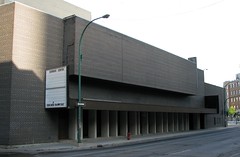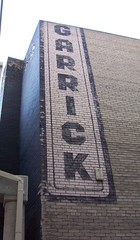Place: The Garrick
Address: 330 Garry Street (Map)
Opened: May 16, 1968
Cost: $900,000
Architect: Waismann Ross Blankstein Coop Gillmor Hanna
Contractors: Wallace and Akins
In 1922, Archives of Manitoba, Foote Collection
It was announced in late August 1919 that a consortium of local investors started construction on a new theatre to be named The Garrick on the site of the old Fort Garry Market building on Garry Street. The plans were drawn up by contractor James McDiarmid.
This was a busy time for the construction of large movie theatres in the city with the Allen / Metropolitan Theatre also constructed in 1919 and the Capitol Theatre in 1920.
After some unexpected delays, the $150,000, 1,500-seat Garrick Theatre opened on March 14, 1921. The opening night film was the silent feature "The Shepherd of the Hills."
It was a luxurious building with a lobby that featured marble floors and a fireplace, men's and ladies sitting rooms, an auditorium with oak panelling and upholstered leather seats and an orchestra pit that could easily hold its 12 house musicians. Despite being a movie theatre it also had a small stage to allow for limited use as a live venue.
In 1928, a "monster" pipe organ was installed. (You can read more about that here.)
Exterior renovation likely done in 1953
In 1930, the Garrick was purchased by Henry Morton.
Morton started off as a theatre manager in the 19-teens and by 1925 owned the Gaiety Theatre on Portage Avenue and some smaller, neighbourhood theatres. The Garrick was the biggest in his chain and he spent over $10,000 to upgrade the basic sound system that had been installed the previous year to make the Garrick a "talking picture" house.
In the mid-1940s, his company, by then called Odeon-Morton Ltd., purchased the nearby Walker Theatre. It had gone bankrupt during the Depression and the city took possession of it for back taxes. Morton converted the former live venue into a single-screen movie theatre called the Odeon Theatre.
The rise in the popularity of television through the 1950s meant the end of many neighbourhood theatres and put in doubt the future of aging downtown movie palaces.
The Odeon Morton chain, which also owned the Park, Kings and Hyland, fared better than most thanks to innovative company manager Paul Morton, Henry's son. Their collection of suburban theatres were renovated and programming was changed to appeal to families.
The Garrick underwent a major renovation in 1953 that brought a wider screen and a new sound system. Later that year, it was the first Winnipeg theatre to show a 3-D film; Bwana Devil. (It is likely that during this renovation the exterior of the building was also modernized.)
Morton started off as a theatre manager in the 19-teens and by 1925 owned the Gaiety Theatre on Portage Avenue and some smaller, neighbourhood theatres. The Garrick was the biggest in his chain and he spent over $10,000 to upgrade the basic sound system that had been installed the previous year to make the Garrick a "talking picture" house.
In the mid-1940s, his company, by then called Odeon-Morton Ltd., purchased the nearby Walker Theatre. It had gone bankrupt during the Depression and the city took possession of it for back taxes. Morton converted the former live venue into a single-screen movie theatre called the Odeon Theatre.
The rise in the popularity of television through the 1950s meant the end of many neighbourhood theatres and put in doubt the future of aging downtown movie palaces.
The Odeon Morton chain, which also owned the Park, Kings and Hyland, fared better than most thanks to innovative company manager Paul Morton, Henry's son. Their collection of suburban theatres were renovated and programming was changed to appeal to families.
The Garrick underwent a major renovation in 1953 that brought a wider screen and a new sound system. Later that year, it was the first Winnipeg theatre to show a 3-D film; Bwana Devil. (It is likely that during this renovation the exterior of the building was also modernized.)
November 11, 1967, Winnipeg Free Press
Through the 1960s, attendance at Morton's two downtown theatres continued to decline and they had a new threat on the horizon in the form of new, suburban mall theatres. Morton needed to do something fast if he was going to stay in business.
In the United States, the movie theatre industry found that it could compete with television and mall theatres by building modern, custom-built cinemas with state-of-the-art sound and projection systems.
Morton decided that this is what his company would do and chose the Garrick as the building that would be demolished to make way for a new theatre. It showed its last film in November 13, 1967.
May 16, 1968, Winnipeg Tribune
Local firm Waismann Ross Blankstein Coop Gillmor Hanna, (now known as Number 10), was hired to design the 1,430 seat, $900,000 complex. It would be Winnipeg's first multi-plex with two cinemas under one roof. The north portion, which would become Cinema 2, would reuse some of the existing, 70-foot-wide building, while the southern half would be all new construction on the site of the old Strand Billiard Hall which had burned down some time before.
The new Garrick boasted British-made convex screens. It also housed the latest Italian projection equipment and a sound system imported from Japan. The seats were modern and plush with extra leg room between rows and featured a bold purple, blue and orange colour scheme.
Outside, windows lined the main floor providing natural light into the lobby and concession area. Infrared heating lamps located under the overhang were to keep patrons warm while waiting in line on the sidewalk, though they proved no match against a Winnipeg winter.
Owner Paul Morton and manager M. W. Vint, formerly of the King's Theatre, officially opened the new Garrick Cinema on May 16, 1968. The 619-seat Cinema 1 showed Dean Martin and Stella Stevens in "How to Save a Marriage and Ruin Your Life", while the 810-seat Cinema 2 featured Burt Lancaster in "The Scalphunters".
A Free Press reviewer wrote of the new theatre: cinemas: "The dual cinema complex itself is a sumptuous and much-needed addition to downtown Winnipeg.... The new Garrick is a long way from the seedy popcorn palaces which predominated on the Winnipeg movie scene until the 1960s."
In 1979, Morton added two more cinemas to the complex, making it Winnipeg's first four-plex. The addition was designed by Dalton Engineering and Construction and built by Malcolm Construction to the north of the where a parking lot was located.
The additional cinemas, each with 300 seats, opened on December 21, 1979.
In May 1980, Paul Morton announced that he was selling the Morton family share of Odeon-Morton, which had 16 cinemas in Manitoba and Saskatchewan, to the Odeon Corporation of Toronto.

December 24, 1974, Winnipeg Free Press
A local pop-history note about the Garrick Cinema is the remarkable run of "Phantom of the Paradise".
Despite disappearing from the rest of North America's cinemas soon after opening, in Winnipeg it became a cult classic and ran at the Garrick 2 from Boxing Day 1974 to April 30, 1975, (it continued on for another month or so at other venues.)
In 1999, Cineplex Odeon announced that their corporate strategy was moving towards larger cinemas and that the Garrick Cinema would close by the end of the year.
The following year, the Marlborough Hotel located just across the back lane purchased it and began a multi-year, $1.5 m renovation of the building.
The building was initially rechristened the Ramada Conference and Entertainment Centre and connected to the hotel via a walkway. It had three auditoriums: the 600-seat Garrick One live venue hall; the 550-seat Garrick Two live venue hall, and the 250-seat Garrick Four lecture hall. The former Garrick Three is home to the hotel's pool and water slide.
The building has since been renamed The Garrick and has become one of the city's premiere music venues.
Related:
- 330 Garry Street Winnipeg Architecture Foundation
- Photos of the old Garrick Cinemas
- Garrick Cinema CinemaTreasures.org
- For more on Winnipeg's connection to Phantom and the two Phantompalooza reunions that have been held.
- Whatever happened to: The Garrick Theatre's "monster" organ? West End Dumplings









The Garrick is sort of an underdog of a venue. It gets very little publicity, but it's not a bad place to see a show. I saw Robert Cray there this year, and a free concert featuring Keith & Renée and two other artists -- both of which I basically just stumbled upon.
ReplyDeleteFun fact: I was in high school when my teacher, Mr Warkentin, organized the first Phantompalooza, and my friends and I (students of his) helped him! We met Beef and it was amazing.
ReplyDeletePS nice meeting you today!
Those are my photos of the Garrick on Film-Tech and I have hundreds more in better quality I've been planning to put online.
ReplyDeleteIt was a great movie theatre and was actually in pretty good shape in it's final days. I haven't come across another theatre that shares a similar ceiling with those Garrick 1 and 2 houses, but I'm glad the hotel kept the place mostly in tact.